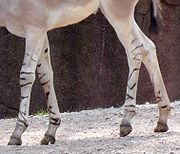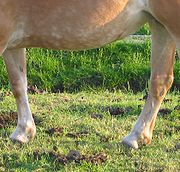
Chestnut (horse anatomy)
Encyclopedia
The chestnut, also known as a night eye, is a callousity on the body of a horse
or other equine, found on the inner side of the leg above the knee on the foreleg and, if present, below the hock
on the hind leg.
Chestnuts vary in size and shape and are sometimes compared to the fingerprints in humans. For purposes of identification some breed registries
require photographs of them among other individual characteristics. However, because chestnuts grow over time and horse grooms often peel or trim off the outer layers for neatness, their appearance is subject to change.

 The evolution of the horse
The evolution of the horse
involved a reduction in the number of toes to one, along with other changes to the ancestral equid foot. The chestnut is thought to correspond to the wrist pad of dogs and cats, or to be a vestigial scent gland similar to those found in some deer and other animals.
The domestic horse is almost alone among extant equines in having chestnuts on the hind legs. Chestnuts are absent from the hind legs of ass
es and zebra
s. The majority of domestic horses have chestnuts on all four legs, as does the Przewalski's horse
, but a few horse breed
s are reported to lack chestnuts on the hind legs. These include:
Horse
The horse is one of two extant subspecies of Equus ferus, or the wild horse. It is a single-hooved mammal belonging to the taxonomic family Equidae. The horse has evolved over the past 45 to 55 million years from a small multi-toed creature into the large, single-toed animal of today...
or other equine, found on the inner side of the leg above the knee on the foreleg and, if present, below the hock
Hock (zoology)
The hock, or gambrel, is the joint between the tarsal bones and tibia of a digitigrade or unguligrade quadrupedal mammal, such as a horse, cat, or dog...
on the hind leg.
Chestnuts vary in size and shape and are sometimes compared to the fingerprints in humans. For purposes of identification some breed registries
Breed registry
A breed registry, also known as a stud book or register, in animal husbandry and the hobby of animal fancy, is an official list of animals within a specific breed whose parents are known. Animals are usually registered by their breeders when they are still young...
require photographs of them among other individual characteristics. However, because chestnuts grow over time and horse grooms often peel or trim off the outer layers for neatness, their appearance is subject to change.
Distribution among equines


Evolution of the horse
The evolution of the horse pertains to the phylogenetic ancestry of the modern horse from the small dog-sized, forest-dwelling Hyracotherium over geologic time scales...
involved a reduction in the number of toes to one, along with other changes to the ancestral equid foot. The chestnut is thought to correspond to the wrist pad of dogs and cats, or to be a vestigial scent gland similar to those found in some deer and other animals.
The domestic horse is almost alone among extant equines in having chestnuts on the hind legs. Chestnuts are absent from the hind legs of ass
Asinus
The subgenus Asinus encompasses four species and several subspecies of Equidae characterized by long ears, a lean, straight-backed build, a scant tail, and a reputation for considerable toughness and endurance....
es and zebra
Zebra
Zebras are several species of African equids united by their distinctive black and white stripes. Their stripes come in different patterns unique to each individual. They are generally social animals that live in small harems to large herds...
s. The majority of domestic horses have chestnuts on all four legs, as does the Przewalski's horse
Przewalski's Horse
Przewalski's Horse or Dzungarian Horse, is a rare and endangered subspecies of wild horse native to the steppes of central Asia, specifically China and Mongolia.At one time extinct in the wild, it has been reintroduced to its native habitat in Mongolia at the Khustain Nuruu...
, but a few horse breed
Horse breed
Horse breed is a broad term with no clear consensus as to definition, but most commonly refers to selectively bred populations of domesticated horses, often with pedigrees recorded in a breed registry. However, the term is sometimes used in a very broad sense to define landrace animals, or...
s are reported to lack chestnuts on the hind legs. These include:
- Banker horseBanker HorseThe Banker horse is a breed of feral horse living on the islands of North Carolina's Outer Banks. It is small, hardy, and has a docile temperament...
(most individuals) - Caspian ponyCaspian ponyThe Caspian is a small horse breed native to Northern Iran. Although its original height probably ranged between 9 and 11.2 hands high, it is termed a horse rather than a pony because, size apart, it has much in common with horses...
(some individuals)

